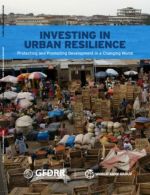Investing in Urban Resilience: Protecting and Promoting Development in a Changing World

Investing in Urban Resilience, by Santos and Leitmann, is a flagship report that succinctly “explores the rationale for increasing investment in the resilience of cities and their citizens to natural disasters and climate change” (page 12). Against a backdrop of growing urbanization, urban poverty, and climate-related hazards and risks, Investing in Urban Resilience highlights the gravity of failing to invest in resilience for both economic growth and poverty reduction. The report identifies a window of opportunity for cities and investors to meet the challenge of urban resilience in low- and middle-income countries.
This is a timely publication in light of the New Urban Agenda (outcome of Habitat III) and the World Bank Group (WBG) mandate to invest in urban resilience, alongside other international initiatives. It thus provides relevant reading for, but is not limited to, stakeholders in vulnerable cities, potential investors in urban resilience, and existing and future partners working to advance urban resilience.
Investing in Urban Resilience is very accessible and easy to read. An executive summary provides a clear overview of the report, while the main body of the report is divided into four key chapters: “Why do we care about urban resilience”; “Why urban resilience matters to the urban poor”; “Financing needs and overcoming obstacles”; and “Opportunities: how the WBG can add value to urban resilience”.
Chapter 1 defines urban resilience and sets forth why it is urgent to invest in it now. In light of goals to end extreme poverty and promote shared prosperity, it also outlines an increasing international focus on urban resilience.
Chapter 2 begins by describing the increasing urbanization of poverty that we are experiencing and are set to see in the future. Considering this, it identifies the factors that increase the risks faced by the urban poor, such as housing and livelihood locations and limited economic bases. The chapter then highlights the growing awareness of the linkages between poverty and urban resilience.
Chapter 3 turns first to the financing needs required for making cities more resilient. Secondly it discusses four broad categories of obstacles that inhibit financing of urban resilience. The chapter ends by considering the potential of private investment for increasing urban resilience.
Chapter 4 in essence looks at the opportunities ahead. It explores what strategies are currently in place to help secure resilience funding, and examines where the WBG has comparative advantages. In this light it identifies the World Bank services for supporting urban resilience, such as technical assistance and financing approaches, and considers what the WBG will do differently to make cities more resilient.
After these four chapters are four annexes. They provide: sample definitions of urban resilience; a World Bank urban resilience portfolio; a list of World Bank instruments for investing in urban resilience; and external and internal partnerships for urban resilience.
Available from:
https://openknowledge.worldbank.org/handle/10986/25219
Book note prepared by Hannah Keren Lee
Search the Book notes database
Our Book notes database contains details and summaries of all the publications included in Book notes since 1993 - with details on how to obtain/download.
Use the search form above, or visit the Book notes landing page for more options and latest content.
For a searchable database for papers in Environment and Urbanization, go to http://eau.sagepub.com/

